An interdisciplinary team of Carnegie Mellon students has designed and constructed a solar-powered house to compete in the first Solar Decathlon, Sept. 27 - Oct. 4, on the National Mall in Washington, D.C.
The Solar Decathlon is sponsored by the United States Department of Energy (DOE) to educate consumers about solar energy and energy-efficient products that are or will be available in the future. By involving student teams, the DOE also hopes to "provide stimulus to the next generation of researchers, architects, engineers and builders as they prepare to begin their careers."
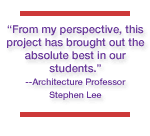 Carnegie Mellon's team is one of 14 from universities around the country competing in the event. Solar Decathlon participants will attempt to depend completely on the renewable energy collected from the sun to power their structures, which include a computer-equipped home office. During daytime hours, the solar-powered houses will store energy from the sun in batteries for use at night.
Carnegie Mellon's team is one of 14 from universities around the country competing in the event. Solar Decathlon participants will attempt to depend completely on the renewable energy collected from the sun to power their structures, which include a computer-equipped home office. During daytime hours, the solar-powered houses will store energy from the sun in batteries for use at night.
Each house must also collect enough solar power to operate an electrically powered Ford Th!nk which the students will use to get around town. After the competition, the golf cart type transportation device will be used by the university's Facilities Management Services as an environmentally friendly maintenance vehicle.
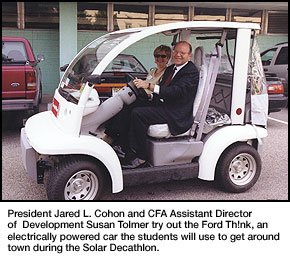
The house, built this summer on campus behind Donner Hall, includes 10-inch thick walls filled with denim fiber manufactured from denim scraps. The recycled cotton fibers have the same insulation value as fiberglass, but are friendlier to the environment and to the installer's health. Other energy-efficient characteristics include triple-pane windows, solar panels that convert sunlight to electrical current and more than 100 evacuated glass tubes to produce hot water. An electric heat pump will heat and cool the facility.
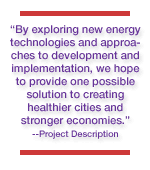 The floor of the house is constructed with interchangeable bamboo plywood tiles. Some of the tiles include electrical and computer connections that can be moved anywhere in the house. Each faucet in the house has its own flexible water line that is connected to a central manifold. The air for heating and cooling is circulated through the house after passing through an energy efficient heat recovery ventilator.
The floor of the house is constructed with interchangeable bamboo plywood tiles. Some of the tiles include electrical and computer connections that can be moved anywhere in the house. Each faucet in the house has its own flexible water line that is connected to a central manifold. The air for heating and cooling is circulated through the house after passing through an energy efficient heat recovery ventilator.
"From my perspective, this project has brought out the absolute best in our students," said Architecture Professor Stephen Lee, a faculty advisor to the project. "It has increased their focus on sustainable design and urban revitalization, and innovation in design, and has enabled them to conduct and apply research to a greater depth than the usual design studio. The project has also helped them to develop the ability to work in multi-disciplinary teams, and to learn from the process of translating drawings into reality.
"The dedication and commitment of the students to this project, has made this
a rewarding experience for all of the faculty involved."
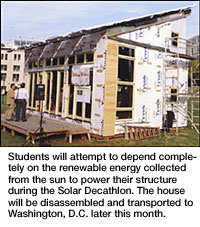 The house will be disassembled on Sept. 18 and transported from campus to Washington, where it will be rebuilt on the National Mall. The structure will be judged in 10 different categories—Design and Livability, Design Presentation and Simulation, Graphics and Communication, the Comfort Zone, Refrigeration, Hot Water, Energy Balance, Lighting, Home Business and Getting Around.
The house will be disassembled on Sept. 18 and transported from campus to Washington, where it will be rebuilt on the National Mall. The structure will be judged in 10 different categories—Design and Livability, Design Presentation and Simulation, Graphics and Communication, the Comfort Zone, Refrigeration, Hot Water, Energy Balance, Lighting, Home Business and Getting Around.
After the Solar Decathlon the house is expected to be used by students on campus before being donated to a Pittsburgh neighborhood. East Liberty and Garfield are being considered as the permanent site of the solar-powered house.
The Carnegie Mellon team concept is titled "Resolution," and plays off of the meaning of the word.
"Resolution refers to problem solving and commitment. As a team of students and advisors, we dedicate our resources with the belief that individuals can make a difference. By exploring new energy technologies and approaches to development and implementation, we hope to provide one possible solution to creating healthier cities and stronger economies," states the project description.
About 20 students participated in the actual construction of the project, however, more than 40 students have helped in the preparation. Classes that helped students think and prepare for the Decathlon have been going on at Carnegie Mellon as early as the fall of 2001.
 Carnegie Mellon's team consists of students from the School of Architecture, the School of Design and the Mechanical Engineering Department. Advisors include Lee, Architecture Professor Thomas Spiegelhalter and School of Design Professor Liza Wellman.
Carnegie Mellon's team consists of students from the School of Architecture, the School of Design and the Mechanical Engineering Department. Advisors include Lee, Architecture Professor Thomas Spiegelhalter and School of Design Professor Liza Wellman.
In addition to the DOE, other national sponsors for the Decathlon include the National Renewable Energy Laboratory, BP Solar, the American Institute of Architects, Electronic Data Systems and Home Depot.
The Heinz Endowments, the Pennsylvania Department of Environmental Protection, P.J. Dick Inc., the AIA Pittsburgh Foundation and many other individual architectural and construction firms in the region are sponsoring the Carnegie Mellon team.
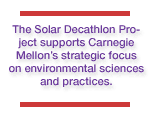 The team has received material donations from the Viessmann Company, Weathershield, Dietrich Industries and Stirling Technologies.
More information on Carnegie Mellon's team is available on the Web at www.arc.cmu.edu/carnegie_team/.
The Solar Decathlon Web site is www.eren.doe.gov/solar_decathlon/index.html.
The team has received material donations from the Viessmann Company, Weathershield, Dietrich Industries and Stirling Technologies.
More information on Carnegie Mellon's team is available on the Web at www.arc.cmu.edu/carnegie_team/.
The Solar Decathlon Web site is www.eren.doe.gov/solar_decathlon/index.html.
Laine Towey and Teresa Thomas
(09/06/02)